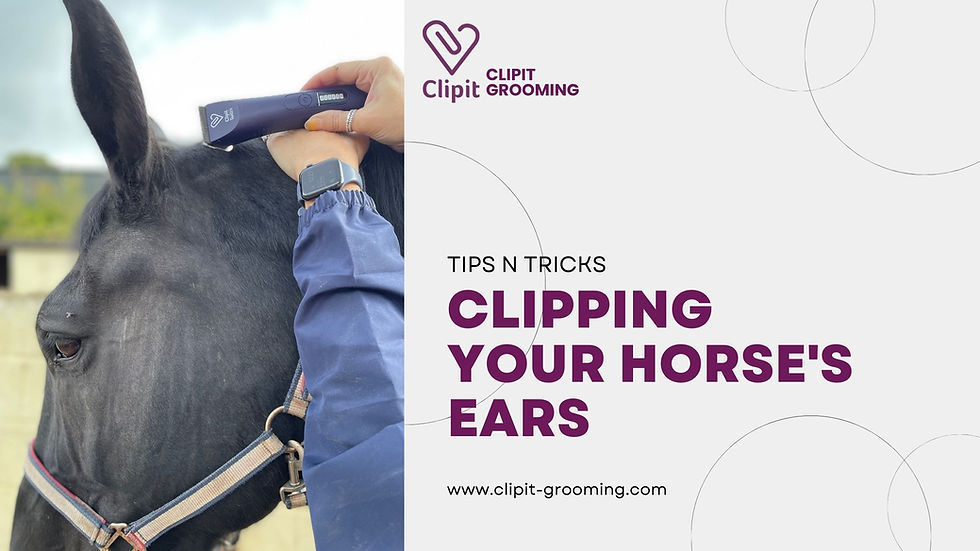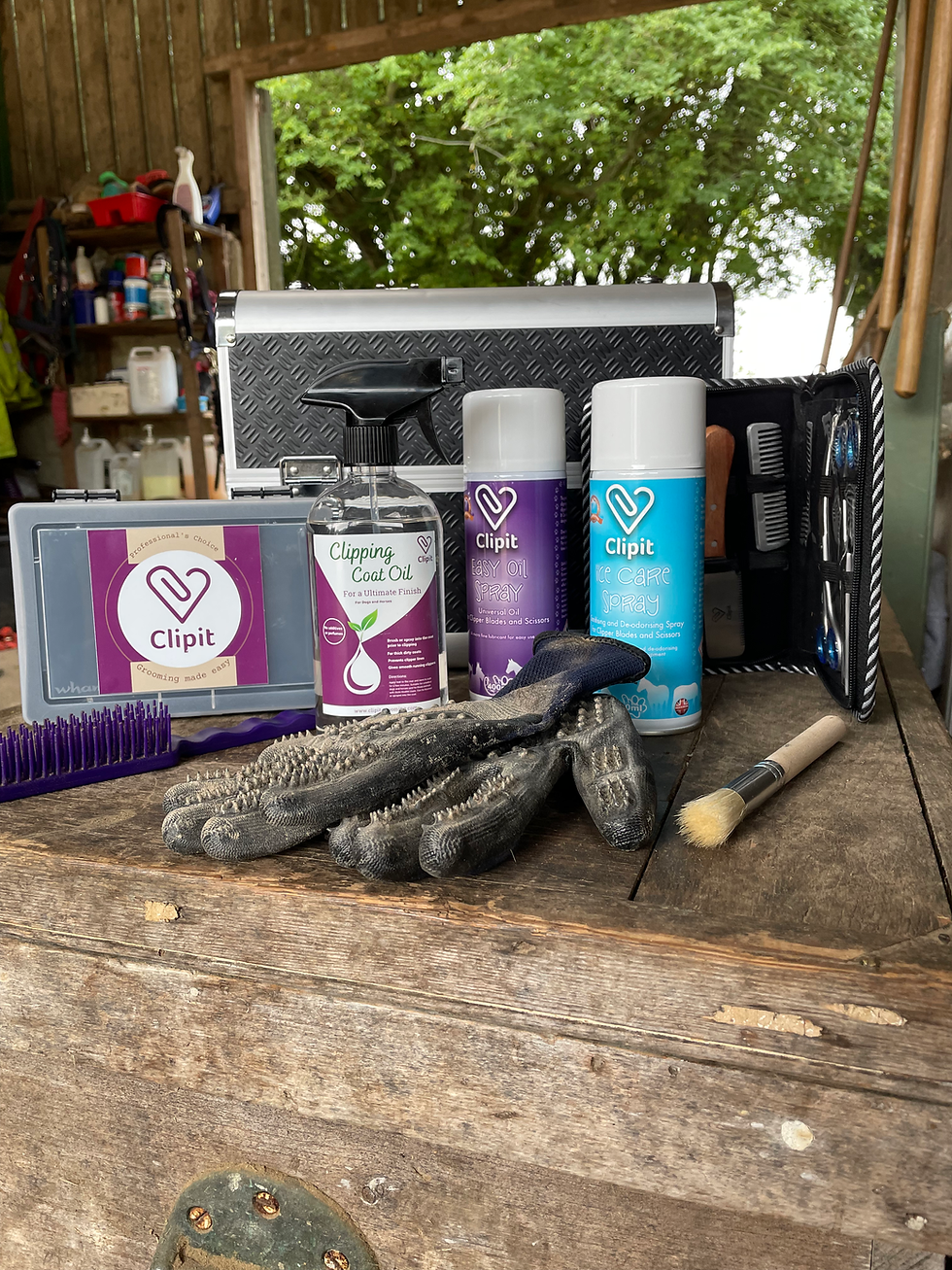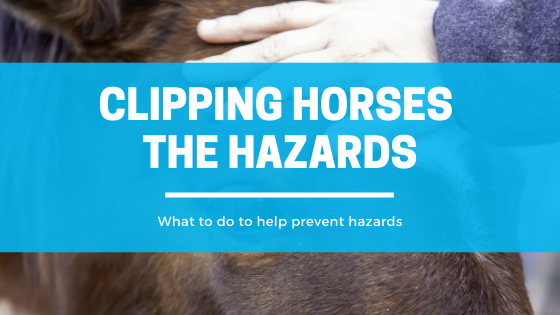Clipping Your Horse's Ears
- Aug 25
- 5 min read
Updated: Aug 27
When it comes to grooming, clipping your horse’s ears can be one of those delicate jobs that requires both skill and consideration. Not only does it affect your horse’s comfort and appearance, but it also has welfare implications if done incorrectly.

Whether you’re preparing for a competition or simply tidying your horse for everyday management, ear clipping should always be approached with patience, the right tools, and a good understanding of your horse’s needs.
Why Clip a Horse’s Ears?
Horses naturally have hair inside and around their ears, which helps protect against insects, dust, and debris. However, you may choose to trim or clip your horse’s ears for several reasons:
Tidiness and Presentation: For showing and competition, neatly clipped ears give a polished look.
Practicality: Excess hair can trap dirt and debris, making the ears harder to clean.
Comfort: In some cases, trimming overgrown ear hair can make it easier for the horse to wear bridles, head collars, or ear bonnets.
That said, it’s important to remember that ear hair has a purpose. Completely removing all the inner hair can reduce your horse’s natural protection from bugs and the sun, so many owners opt for a tidy-up rather than a total clip.
A fly mask worn during the day, and some fly spray (applied by hand) can help during riding.

Clipping a Head-Shy Horse
Some horses are naturally sensitive around their head and ears, making clipping a real challenge. Ear clipping, in particular, can trigger resistance or even fear if not approached carefully. The key is to go slowly and build trust over time.
Tips for Clipping a Head-Shy Horse:
Start away from the ears – let your horse hear the clippers running near their shoulder or neck before moving towards the head. This helps them get used to the sound and vibration.
Use lots of praise and reward – a calm voice, strokes, and even small treats make a big difference in building positive associations.
Introduce gradually – hold the clippers near the ear without clipping at first. Reward your horse for standing quietly. Only progress when they are relaxed.
Don’t force it – if your horse becomes anxious, step back and try again later. Rushing will only make them more nervous next time.
Consider quieter clippers – a lightweight, low-vibration trimmer (like the Clipit Quattro) can be much less intimidating for sensitive horses.
With time, patience, and consistent reward, even the most head-shy horse can learn to accept ear clipping as part of their routine.
Clip for Your Horse’s Lifestyle
When deciding how much to clip around the ears, it’s important to think about your horse’s lifestyle. Not every horse needs a full inside-and-out clip—sometimes a light tidy is enough.
Competition Horses – For showing and dressage, neat, sharp outlines around the ears give a polished finish. Many riders clip the edges and lightly tidy inside for a smart presentation.
Leisure Horses – If your horse mainly hacks out or does light work, leaving more of the natural hair inside the ears provides extra protection from flies, dust, and weather. A simple trim around the outside for tidiness is usually best.
Field Kept Horses – Horses that live out benefit from keeping most of their ear hair for warmth and protection. In this case, avoid clipping the inside altogether—just tidy the tips if needed.
Sensitive or Head-Shy Horses – For these horses, less is more. Focus on comfort and safety, not perfection. Often, a quick tidy around the outer edges is all that’s necessary.
Clipping isn’t one-size-fits-all. Think about your horse’s daily life, environment, and comfort before you decide how much to trim—always balancing appearance with welfare.
Tools You’ll Need
To clip your horse’s ears safely and effectively, you’ll want to use the right equipment:
Quiet, lightweight clipper or trimmer (such as the Clipit Quattro Cordless for sensitive areas).
Small safety scissors for fine tidying.
Clipper oil or spray to keep blades cool and running smoothly.
A soft brush or cloth to remove loose hair afterwards.

Step-by-Step: How to Clip Your Horse’s Ears
Preparation is key Make sure your horse is calm, tied securely, and used to the sound of clippers. Some horses are very sensitive around their ears, so introducing the sound and vibration gradually is essential.
Decide on the style
For shows: Many riders clip the outer edges and tidy the insides for a sharp, smart look.
For everyday management: Simply trimming long hairs that stick out can be enough.
Clipping the outside Close the ear gently and run the clipper or trimmer along the outer edges. This gives a neat outline without disturbing the delicate inside.
Tidying the inside (optional) If you’re clipping the inside, gently fold the ear closed and trim only the hairs that stick out. This way, you maintain some protection while still creating a tidy appearance.
Aftercare Once finished, brush away loose hair and check your horse’s ears for any nicks or irritation. Apply a little soothing gel if necessary.

Safety and Welfare Tips
Never force it. If your horse is ear-shy, work slowly, use positive reinforcement, and never rush.
Keep clippers cool. Hot blades can cause discomfort and make horses even more sensitive next time. Find out more about clipper blade care, here.
Know the rules. Some showing classes prefer a natural look, so check before you clip.
Respect the ear’s purpose. Avoid over-clipping – your horse still needs natural protection against flies and the elements.
Using the Clipit Quattro for Sensitive Areas
When working around sensitive areas like the ears, the Clipit Quattro is the perfect choice. Unlike heavy, industrial clippers that can be noisy and intimidating, the Quattro is lightweight, compact, and exceptionally quiet. Its small size makes it easy to handle with precision, while the low vibration helps keep even the most sensitive or head-shy horses calm. For ear clipping, where trust and comfort are key, the Clipit Quattro provides a smooth, stress-free experience for both horse and handler.
Final Thoughts
Clipping your horse’s ears is as much about welfare as it is about appearance. With the right tools, a calm approach, and a respect for your horse’s natural defences, you can achieve a smart, tidy look without compromising comfort. Remember—less is often more when it comes to ear hair.















Comments